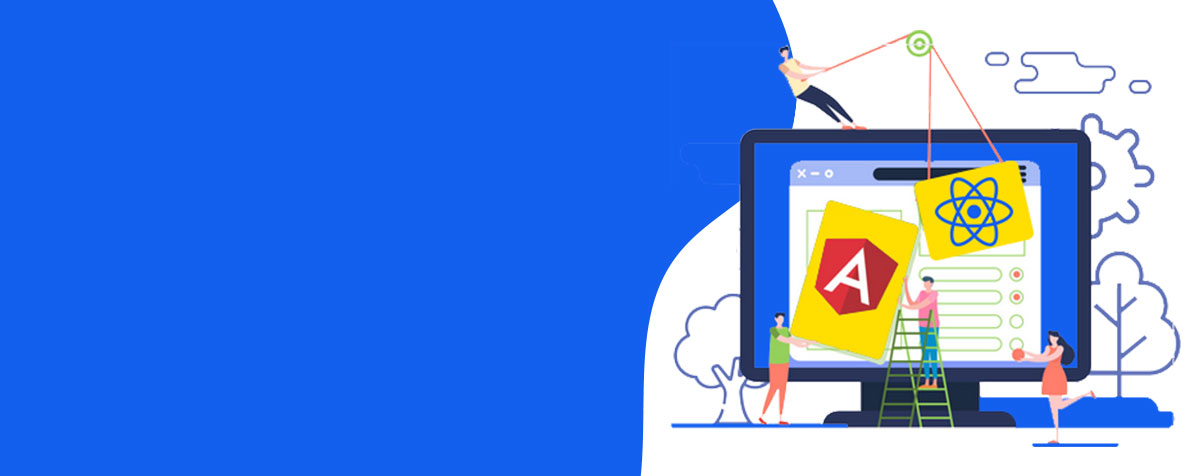The toughest challenge you will face in developing a modern web or mobile app will be an excellent front-end design.The challenge is accentuated by the fact that most users are demanding, and they have come to expect everything from every app. Modern web apps have to balance features such as high interactivity and low resource footprint, the security of data, and quick response time.Using tools designed especially for front-end development simplifies the development effort. React, and Angular are two of the most widely used front-end technologies. But, like everything that comes in two, you must make a choice: Angular vs. React.Both are based on JavaScript and have done exceedingly well in proving their suitability, dominance, and power over the years.Angular, developed by Google, came before React, by Facebook. Today both are open source. Their key differences will help you make an informed decision. Before that, a caveat – it is not an apples-to-apples comparison; you’ll see why.
Why Angular ?
It is a complete framework for a front-end client-side MVC/MVVM. Angular’s latest version 9 was released in Feb 2020.With Angular, you can manipulate any DOM object and extend HTML tags. Easily converts static HTML to dynamic and uses bi-directional data binding with dependency injection to maintain the app state.Significant features of Angular:
- Improved API for testing
- Improvement for Module support
- Angular Forms are improved and easier to use
- Improvement in dependency injection
- Improved support for IDEs like WebStorm and VC code
- Simpler Service workers
- Improved internationalization support
- Improved API extractor to create reports
- Improved gesture support
- Use cases: Google, Nike, HBO, Sony, Forbes.
You can Hire ReactJS Developers and Hire Angular.JS Developers now.
Why React ?
React is a JavaScript library, not a framework, to handle user interface only that is also maturing. Its version 16 was released in November 2019.React features include:
- Improved profiler
- Improved emulation of testing the application in the browser and running it asynchronously
- Fixes for memory leaks, handling infinite loops, etc.
- Use case: Facebook, Airbnb, Uber, Netflix, Instagram
When considering their differences, we will keep a score for easier comparison.
What Developer Community Thinks
On Github, React has 13,000 plus commits and more than 140,000 likes. In contrast, Angular has close to 17,000 commits, but only 57,000 likes.The community prefers React over Angular. The reason could be a bit historical as Angular’s 1st release in 2010 was very bulky and bug-ridden, leaving a bad taste.Angular: 0, React: 1
Ease of Mastering the Tool
If you have a close deadline, then you don’t want your team to spend too much time learning a new tool.Angular, being a framework, needs more time and effort on your part to master and use. However, its documentation is far more meticulous and detailed. The primary reason is its dependency on TypeScript, and the developers must additionally learn that language.React, only a library of JavaScript modules and functions is much faster to learn and apply.Angular: 0, React: 2
Framework vs. Library
Being a full-fledged web/mobile development framework, Angular is more powerful, heavier, slower, and high on memory usage. React, on the other hand, is a library designed only to develop front-end UI and, therefore, lighter, faster, and uses much less memory.Adding templates, tools, additional frameworks, and testing tools are simpler in React than in Angular, just because it is a library.Working with the Angular framework, everyone on the team must follow the company’s standardized best practices. However, developers for the React library have more freedom to decide on the code structure, use additional libraries, and make code more personalized.Angular: 1, React: 2
Mobile Implementation
Both offer solutions to migrate the code to mobile. Angular uses the Ionic framework and uses Cordova wrapper to deploy on iOS and Android.React’s solution is React Native – creating a real native app instead of a wrapper. With it, you can even bind native Objective-C, Java, or Swift code with your app. In this parameter, React has a clear advantage over Angular.Angular: 1, React: 3
Testing Tools
React uses Facebook’s Jest, with Enzyme, to test apps with a mocking library. Its testing capabilities are often limited.Angular uses Jasmine and Mocha for testing. Protractor, Karma, and browser debug tools, such as Augury are also used for testing Angular code. Its testing tools are more comprehensive and provide better cross-framework support on Node.js.Angular: 2, React: 3
You can Hire ReactJS Developers and Hire Angular.JS Developers now.
Mode Of Operation
In their modes of operation, React, and Angular are fundamentally different. As React provides HTML functionality inside of JavaScript, Angular, on the other hand, provides JavaScript functionality inside of HTML.Angular is more structured and more constrained compared to React, being a framework. Experienced developers prefer a library as it gives them more flexibility, and integrating libraries with existing codebase is far easier.However, for new programmers, frameworks are conducive as a pre-structured application is available and are not overwhelmed by many files to be created. So not pointing to any of them.Angular: 2, React: 3
Size Of The Package
The Angular framework is quite large in size compared to the React library. The file size for Angular 9 is approximately 349 kB (gzip), which is almost over 8x the size of React at 42 kB (gzip). The difference in size comes from the fact that the Angular package includes its source code and many tools like TypeScript-to-JavaScript compiler.Angular: 2, React: 4
Integration with Existing Application
Importing a code library to an existing application is always much simpler; you can choose which parts to use and leave. With frameworks, it is an entirely different ball game. The codebase needs to be retrofitted for the new framework, and sometimes a complete overhaul is necessary.As React is a JavaScript library, therefore, importing it into your existing application is as simple as copying its files to your working directory to plugin the library. Angular, as mentioned earlier, uses TypeScript, and you can’t just plug-it-in into your project. Integrating Angular in existing applications requires effort and time.Angular: 2, React: 5
Rendering
Search engines like Google and Yahoo readily crawl and index pages rendered at the client using JavaScript, used by both React and Angular, some like Baidu may pose SEO issues. Server-side rendering or SSR shortens the time needed to render the page on the client-side and overcomes this problem.Both Angular and React allow SSR, though the process may differ, the time needed for it is comparable. So, no significant differences there.Angular: 2, React: 5
Data Binding
React only supports unidirectional data binding, and data-coupling is not tight. One-way data flow makes it easy to understand what the code is doing and to find and fix the bugs. React can be used only for state management with its immutable data tree.Angular supports both unidirectional and bi-directional data binding. The data and the UI are tightly coupled, and changing one means changing the other. With bi-directional data binding debugging the application becomes complicated. At the same time, mutable data makes it easier with reflection to update data across your app.Angular: 3, React: 5
Usage, Debugging and Code Reuse
With Angular having its own data flow, it is a complex system to write and debug code. React provides an easy to use library with easier debugging facilities. Code-reuse is also easier with React.Angular: 3, React: 6
Document Object Model (DOM) Model
In front-end coding, DOM calls are expensive and time-consuming as they require parsing the HTML document tree.React minimizes the number of DOM using Virtual DOM, making its performance faster. React code (Fiber) can make small changes without changing the entire DOM tree by updating for the difference between previous and current HTML.Angular employs change detection to update the DOM tree and takes longer.Angular: 3, React: 7
Conclusion
Angular and React are both excellent front-end tools, and both have their advantages and limitations. For you, the choice depends on your requirements, your team’s experience, and the project timelines.The above stated Angular vs. React face-off gives you a roadmap to decide which one to choose for a given project. At Raindrops Infotech, we recommend the correct platform to our clients after a thorough and objective assessment based on the above criteria.Using a framework is sometimes very demanding, but it is a must-have for larger teams and more complex projects. If the project demands that MVC or MVVM frameworks be applied, then Angular is an excellent fit. For a small team, between one to three developers, or for smaller projects, React is the go-to option.As you can see, just like coffee or tea, there is no rule of thumb to decide for you; instead, you must choose after carefully analyzing each of these parameters.
No matter if you want Angular JS development services or wish to hire app developer in California, we have a large team to cater to all your needs.
Our experienced and professional developers build web apps to achieve your business aims and meet all criteria to deliver an out of the world front-end experience and then some.







